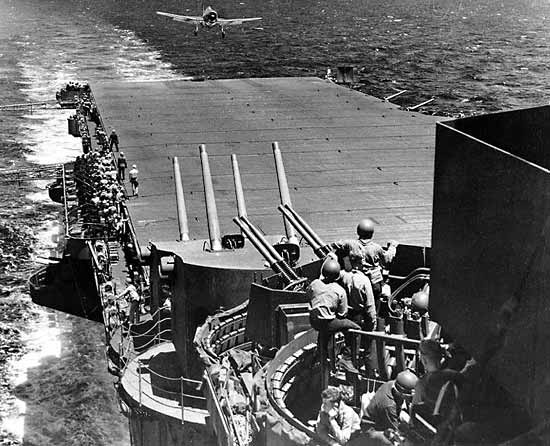Philippine Sea, Battle of the
Japanese-United States history
 (June 19–20, 1944), naval battle of World War II between the Japanese Combined Fleet and the U.S. 5th Fleet. It accompanied the U.S. landing on Saipan and was known as “the greatest carrier battle of the war,” ending in a complete U.S. victory.
(June 19–20, 1944), naval battle of World War II between the Japanese Combined Fleet and the U.S. 5th Fleet. It accompanied the U.S. landing on Saipan and was known as “the greatest carrier battle of the war,” ending in a complete U.S. victory.It began on the morning of June 19, when Admiral Ozawa Jisaburo, determined on a showdown with the U.S. invaders, sent 430 planes in four waves against ships under the command of Admiral Raymond Spruance. The result for the Japanese was a disaster: in the first day of the battle the Japanese lost more than 200 planes and two regular carriers; and, as their fleet retired northward toward safe harbour at Okinawa, it lost another carrier and nearly 100 more planes. Having already achieved a great victory, Spruance decided late on the second day not to press his attack further, a controversial decision to this day. During the two days of battle, U.S. losses totaled 130 aircraft and some damage to ships.
The poor showing by the Japanese has been attributed to many factors, but two may be singled out for special mention: pilots and their aircraft. Some Japanese pilots went into action with as little as three months of training, whereas many U.S. pilots had spent two full years in training. Japanese planes were highly maneuverable and had a longer range than U.S. planes, but they were inferior in several respects, particularly in their inadequate armour protection and lack of self-sealing fuel tanks. U.S. submarines also played an important but less publicized role in providing U.S. commanders with intelligence of enemy movements and in sinking Japanese ships.
- Quaker Foods and Beverages
- quaking grass
- qualitative chemical analysis
- Quanah Parker
- Antigone
- Antigonid Dynasty
- Antigonus II Gonatas
- Antigonus III Doson
- Antigonus I Monophthalmus
- antigorite
- Antigua and Barbuda
- Antigua and Barbuda, flag of
- Antigua Guatemala
- antihero
- antihistamine
- Anti-Lebanon Mountains
- Antilles
- Antilles Current
- Antilochus
- antimacassar
- Antimachus of Colophon
- Anti-Masonic Movement
- antimatter
- antimetabolite
- antimicrobial agent